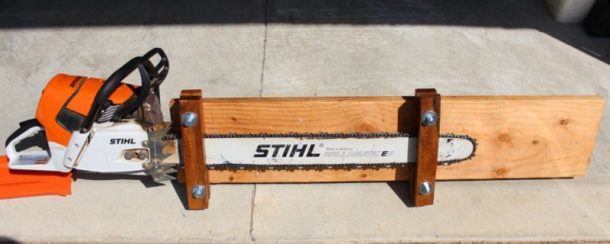For years I have wanted a full sized shop. In order to do this we needed to find a place to erect the shop. Of course, the location that we are able to get isn’t ideal. There is a slope of about 18 inches from front to back. So, it is time to put in the foundation of a business. An actual foundation that the business can sit on and start generating real income.
While this can be a wonderful metaphor for life, in this case I needed to create a structure to build my business upon.
Construction Concerns
Tennessee has a bit of an issue with an invasive insect known as the Formosan Subterranean Termite. This rules out a foundation of wood. While Pressure treated wood is good for contact with damp soil and is resistant to these Termites, I chose to install a stone retaining wall and level the building foundation with stone. There won’t be any issues with Termites eating into this material.
The structure that we will be putting up sits on metal floor joists so on top of the stone, there will be another 6 inches of metal before the first wood. I am hoping that all of this non-edible material under the structure will be sufficient to create a barrier to these gnawing insects.
To fully protect the exterior I will be spraying with Timbor around the full foundation before installation of the building.
Design Considerations
I went round and round a couple of times tring to decide if I wanted the building to sit on concrete piers or on a gravel foundation. The piers would have required building forms and pouring concrete into excavated holes. This would have provided a good barrier to insect attack and make it easy to run any plumbing or ductwork under the floor.
Tennessee isn’t a horribly cold area in the winter so a minimum of insulation would be necessary to keep the floor warm in the winter. The more difficult season is the summer. A solid foundation of stone will keep the floor at a reasonable temperature in the winter and provide some cooling action in the summer as it will take a long time for the thermal mass to come up to ambient temperature.
The Foundation of a Foundation
The start of the retaining wall is an excavation. The lowest level of the block wall needs to be at least 1/2 a block (2 inches) below the surface of the ground. The blocks need to be level and step down as the ground receeds from level. They also need to have a strong supporting surface. I chose to compact a level surface of 3/4 inch crusher run gravel 2 inches deep into the bottom of the trench that I dug.
Finding Level
Before I could start on the trench, I needed to establish a level line. Each corner of the foundation needed to be square and referenced to this line.
I drove stakes into the ground just outside of the intended position for the retaining wall. Each pair of stakes was connected by a 2×4. This way, I could set the height of the line so that it was level and adjust the direction enough to get the stringlines square to each other. I used a small level called a line level to determine when the line was level. These are small inexpensive bubble levels that hang on Mason string.
Finally, I verified that all of the lines were at the right height with a laser level that I picked up at Lowes. This
self-levelling laser sits on a standard camera tripod and shoots a red laser out in 3 directions. I used a folding ruler and measured up from the stringline near where I set the level to the laser point, then verified that the dimension was the same at random points all around the foundation. The strings needed to be adjusted a bit to this line but when complete, I was confident that the entire outline of the wall could be set to the stringline and be level throughout the entire area.
With the line in place, I measured down 4 inches and removed a trench 12 inches wide. As the ground receeded from the line, I stepped the trench down in 4 inch increments so that I could add a full stone and keep the top of the wall level. When the trench was excavated, I filled in the bottom 2 inches with the crushed stone and tamped it down loosely.
With the trench complete and mostly levelled, I started laying stone. Each stone was placed and levelled with a 6″ torpedo level in 2 directions. When a few were down, I checked the level with a 4 foot carpenters level. Each stone needed to be individually tapped into place with a rubber mallet. I added or removed the compacted foundation stone as needed to get each piece levelled in place.
Then, it was rinse and repeat until all 180 stones were in place. Several long days in the sun felt good to get these old bones working again. Ok, I was sore for a week after this ordeal but, I got it done to my satisfaction. Next up, filling the hole.
Building up the Foundation
Now that the foundation retaining wall was complete, I added a berm on the low side of the wall with fill dirt. I covered this with sod that we removed from the inside of the foundation. This should provide additional strength to the wall where it is 20 inches high. The block is designed to lock together and should not require additional support under 24 inches but to be on the safe side, the additional support was added.
The remainder of the fill dirt (About 4 cubic yards) was layered into the inside of the wall and compacted. On top of this, I placed about 20 Tons of 2 inch crusher run. This is a mix of 2 inch stone, smaller gravel and rock dust. I compacted each layer to create a strong stable drainage under the foundation.
The final 4 inches I added 3/4 inch crusher run. When compacted this felt like walking on concrete. The smaller crusher run stone was also easier to produce a final level to the top of the foundation.
For the final level, I grabbed two pieces of steel conduit at Lowes and set them so that the tops of the conduit were level with the finished surface and embedded in the gravel. Then I used a 2×4 with a straight edge to drag the gravel until it was a nice level surface. Then it was just a matter of repeating the process until I had covered the entire area.
Overall this was a very satisfying project. I was able to borrow a front end loader to move the majority of the 50 tons of stone that went into this foundation. I still worked very hard over 4 full weeks to get it completed and meet the schedule for the installation of the building. I completed the work on Saturday, Trusses for the building were delivered on Monday and the crew with the building arrived late on Tuesday afternoon.
Next up….A shop is installed on the foundation.


WOW! I am so not the construction type – mostly because my brain just doesn’t work that way, but I have always been fascinated by the idea of building something on my own. I really appreciate your step-by-step instruction and am so excited to see the finished product. I also love that you just went ahead and addressed the termite issue ahead of time and made sure to lay a foundation that would hopefully eliminate that problem. What kind of business will be housed on such a solid foundation?
Thanks for commenting Sara,,
We are building a Woodworking business.
I needed to create a shop space to house our business. The foundation is for a 768 square foot Tuff Shed building.
Wow, Craig, what a process but I think you made the right decision with the land lease. Buying something might have been better but when it comes to older buildings and fire damage, you just don’t know what exactly you’re getting and it could end up costing more than you bargained for.
Now, you will have something you have built (with help) and you will know that it’s going to last for some time.
I also like the way the blocks offset towards the inside making the foundation even more sturdy.
Good thing you had a neighbour with a friend who could help with the 50 tons of rock. I can’t imagine what that would have done to your back. Neighbours with friends are good things.
You have detailed this so well that anyone else wanting to do this will have no problem building something similar.
Can’t wait to see the finished product,
Wayne
Thanks Wayne,
We struggled with finding the most cost-effective way to get what we need with a reasonable start-up cost. I think in the long run this location will be a great choice for us.
Not only are their neighbors that have assets like a tractor with a bucket, but our other neighbors are also artists and craftspeople in their own right. This shop will be an asset for them and a way that we can create an artistic community with multiple disciplines.
I’m excited about the possibilities ahead.
Craig
An artistic Community… I’m excited for you as well, Craig. I hope it all comes together for you and your neighbours.
Blessing on you, friend
Hey Craig,
This is an unique article I must say. I appreciate your hard work that you have spent to build a solid foundation of your own. I am fascinated and motivated at the same time by you. Because I want to do something by my own and I liked your step by step instructions that you have given moreover you have explained a lot of things that will help a newbie like me. I want you to be successful in settling down your business and be a motivation to others.
Thank you for writing this helpful article.
You are quite welcome.
Keep in mind if you attempt something like this that each situation is unique. In my case, I was able to get away with a gravel foundation due to the way that the building is engineered. If your situation is in an earthquake zone or has a different type of soil underneath, concrete or another type of foundation may be required.
Thanks for reading